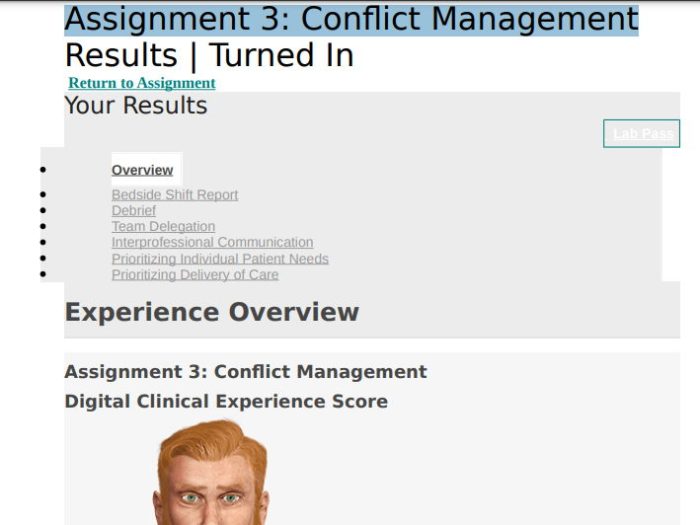Shadow health assignment 5 change management and patient advocacy – Shadow Health Assignment 5: Change Management and Patient Advocacy delves into the intricate interplay between change management and patient advocacy in healthcare. These interconnected concepts shape the delivery of patient-centered care, emphasizing the importance of embracing change while safeguarding patient well-being.
This analysis explores the principles, challenges, and strategies involved in implementing change management and patient advocacy, showcasing their transformative impact on healthcare practice.
Change management involves systematically planning and implementing changes in healthcare settings, addressing resistance and ensuring successful adoption. Patient advocacy, on the other hand, empowers patients and their families, ensuring their voices are heard and their rights are protected. By integrating these concepts, healthcare providers can drive positive change while prioritizing patient-centered care.
Introduction to Shadow Health Assignment 5: Shadow Health Assignment 5 Change Management And Patient Advocacy
Shadow Health Assignment 5 is an interactive online simulation that allows nursing students to practice and apply their knowledge and skills in a realistic healthcare setting. The assignment focuses on change management and patient advocacy, two essential aspects of contemporary healthcare practice.
The purpose of the assignment is to provide students with an opportunity to:
- Develop their understanding of change management principles and theories
- Apply change management strategies to improve patient care
- Understand the role of patient advocacy in healthcare
- Effectively advocate for patients in a variety of healthcare settings
Change management and patient advocacy are crucial components of healthcare because they enable healthcare professionals to:
- Improve the quality and safety of patient care
- Reduce healthcare costs
- Increase patient satisfaction
- Promote a culture of patient-centered care
Change Management in Shadow Health Assignment 5
Change management is a systematic approach to planning, implementing, and evaluating changes in an organization. In healthcare, change management is essential for improving patient care, reducing costs, and increasing efficiency.
Shadow Health Assignment 5 introduces students to several change management principles and theories, including:
- Lewin’s three-step model of change
- Kotter’s eight-step process for leading change
- The ADKAR model of change
Students are also given the opportunity to apply these principles and theories to a real-world healthcare scenario. This allows them to experience the challenges and opportunities of implementing change in a healthcare setting.
Some of the challenges of implementing change in healthcare include:
- Resistance from staff
- Lack of resources
- Time constraints
Despite these challenges, there are also many opportunities for implementing change in healthcare. These include:
- Improving the quality and safety of patient care
- Reducing healthcare costs
- Increasing patient satisfaction
There are several examples of successful change management strategies in healthcare. These include:
- The implementation of electronic health records (EHRs)
- The adoption of value-based care models
- The development of patient-centered medical homes
Patient Advocacy in Shadow Health Assignment 5

Patient advocacy is the process of representing and supporting the rights and interests of patients. In healthcare, patient advocates play a vital role in ensuring that patients receive the best possible care.
Shadow Health Assignment 5 introduces students to the role of patient advocacy in healthcare. Students learn about the ethical principles and legal considerations related to patient advocacy, as well as strategies for effectively advocating for patients in a variety of healthcare settings.
Some of the ethical principles that guide patient advocacy include:
- Respect for patient autonomy
- Beneficence
- Non-maleficence
- Justice
Some of the legal considerations related to patient advocacy include:
- The Patient Self-Determination Act
- The Health Insurance Portability and Accountability Act (HIPAA)
- The Americans with Disabilities Act (ADA)
There are several strategies for effectively advocating for patients in healthcare settings. These include:
- Communicating effectively with patients and their families
- Understanding the patient’s needs and goals
- Developing a plan of action
- Working with healthcare providers to ensure that the patient’s needs are met
Integrating Change Management and Patient Advocacy
Change management and patient advocacy are interconnected. Change management is necessary for implementing new policies and procedures that improve patient care, while patient advocacy is essential for ensuring that the patient’s voice is heard throughout the change process.
Integrating change management and patient advocacy can lead to several benefits, including:
- Improved patient outcomes
- Increased patient satisfaction
- Reduced healthcare costs
- A more patient-centered healthcare system
There are several examples of how change management and patient advocacy have been successfully integrated in healthcare settings. These include:
- The implementation of patient-centered medical homes
- The adoption of value-based care models
- The development of patient advisory councils
Essential FAQs
What is the purpose of Shadow Health Assignment 5?
Shadow Health Assignment 5 aims to provide students with a comprehensive understanding of change management and patient advocacy in healthcare, emphasizing their interconnectedness and importance in delivering patient-centered care.
How are change management and patient advocacy integrated in healthcare practice?
Change management and patient advocacy are integrated by involving patients and their families in the change process, ensuring their needs and perspectives are considered. This collaboration fosters a patient-centered approach that drives positive change and improves healthcare outcomes.